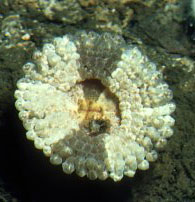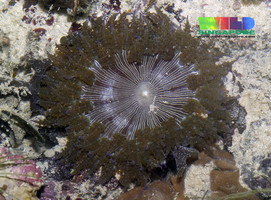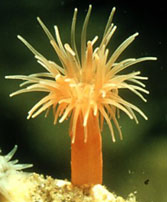Thenaria
Introduction
Carlgren (1949) writes about the classification of Thenaria:Stephenson (1921 p. 541) did not accept the subtribe Thenaria proposed by me, but divided the genera belonging to this group at once into two, Endomyaria and Mesomyaria, the latter including also the genera provided with acontia. As, however, some genera with acontia have no sphincter, it became necessary to set the genera with acontia apart, in a group of equal rank with the Endo- and Mesomyaria (see Stephenson 1935 pp. 28-9). But as I have pointed out several times, it is very doubtful whether the three groups include genera which are always genetically related to each other. For instance the family Aliciidae has certainly nothing to do with the other Endomyaria, but its origin may be found in the subtribe Boloceroidaria. The Mesomyaria also is, to my mind, not a genetically homogenous group, because the mesogloeal sphincter may sometimes have arisen directly from undifferentiated endodermal circular muscles of the column, sometimes from an already differentiated endodermal sphincter. That an endodermal sphincter can in fact become transformed into a more or less mesogloeal one can be seen in Isosisyonis [sic] alba (CARLGREN 1927 p. 54). I have now examined smaller specimens of this species and find that they have an endodermal aggregate sphincter. The Acontiaria also is probably not homogeneous. In support of this opinion the genus Nemanthus gives an instance. At the place where the acontia occur in this genus, organs have appeared which are partly different in structure from acontia. If, therefore, I retain these groups, it is for practical reasons and is only a provisional arrangement.
Characteristics
Nyantheae [sic] with basilar muscles. Aboral end flattened and usually abherent [sic], distinctly differentiated from the column. Bodywall of variable appearance, sometimes divisible into different regions; often with verrucae, marginal spherules or pseudospherules, vesicles or other protuberances. Sphincter usually endodermal or mesogloeal, but sometimes there is no sphincter. Tentacles and mesenteries usually numerous, the former cyclically or radially arranged. Mesenteries rarely differentiated into macro- and microcnemes. Retractors weak or strong, rarely circumscribed. Acontia present or absent.References
Carlgren, O. 1949. A Survey of the Ptychodactiaria, Corallimorpharia and Actiniaria. Kungl. Svenska Vetenskapsakadamiens Handlingar, series 4, volume 1, number 1.
Title Illustrations

From left to right:
- Aureliana heterocera (Endomyaria: Aurelianidae).
Permission by Mr. P.G. Tranter to take this picture in the Marine Biological Station, Plymouth, England is gratefully acknowledged. - Hormathia digitata (Acontiaria: Hormathiidae).
Northern North Sea. Collection and donation of this specimen by Prof. N. Daan (RIVO, IJmuiden, Netherlands) is gratefully acknowledged. - Diadumene cincta (Acontiaria: Diadumenidae).
The Netherlands.
Photographs copyright © 2000, Ron Ates.
| Copyright | © 2005 Ria Tan |
|---|
About This Page
The information provided on this page is based on Oscar Carlgren's 1949 catalog.Copyright © 1949 Swedish Academy of Sciences.
Please note that Carlgren's text contains a number of errors, and much of the information is now out of date. An update of the catalog is currently under preparation in Daphne Fautin's laboratory, and the results of this work will be incorporated in future versions of this page.
Keyboarding of Carlgren's catalog was done as part of a project to create an electronic database of the sea anemones of the world, funded by NSF Grant DEB9521819, awarded to Daphne G. Fautin. This grant is in the program Partnerships to Enhance Expertise in Taxonomy (PEET). Susanne Hauswaldt, Katherine Pearson, and April Wakefield-Pagels contributed to the keyboarding effort.
Correspondence regarding this page should be directed to Daphne G. Fautin at
fautin@ku.edu
Page copyright © 2000
All Rights Reserved.
Citing this page:
Tree of Life Web Project. 2000. Thenaria. Version 01 January 2000 (temporary). http://tolweb.org/Thenaria/17708/2000.01.01 in The Tree of Life Web Project, http://tolweb.org/












 Go to quick links
Go to quick search
Go to navigation for this section of the ToL site
Go to detailed links for the ToL site
Go to quick links
Go to quick search
Go to navigation for this section of the ToL site
Go to detailed links for the ToL site